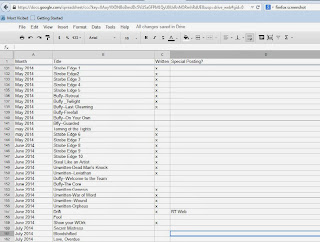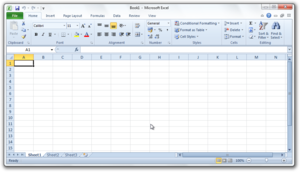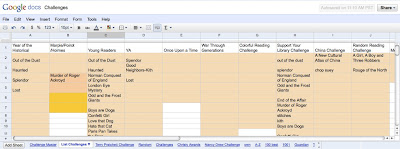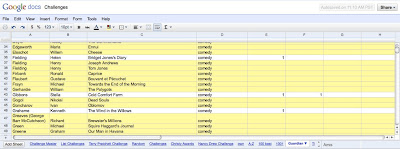I am a complete and utter scatter brain, but I have a lot of responsibility and stuff to do in my professional and personal life. Organization is the only way I stay on top of things and am at all functional.
A few weeks ago, the #readadv chat was on how we stay organized. People were pretty interested in each other's systems and wanted more in-depth info than Twitter really allows. Kelly kicked off some posts here for people to share their systems.
People seemed especially interested in Bullet Journaling, which is my personal system. Here's how I do it. (Followed by why it works for me, and how I organize my reading and blogging, too.)
When I was working and in grad school, I swore by the BusyBodyBook planner, but they no longer make them. I loved the columns for different aspects of my life (work/school/blog/LIFE) and I tried a few other things since then, but nothing that I loved as much. I started doing Bullet Journaling this spring and LOVE IT.
So, if you are unfamiliar with the concept of Bullet Journaling, read all about it here or watch this video.
One of the things I love about this system is that it's very flexible. It's incredibly easy to modify it to fit your needs. I don't like how he does calendars, because I need the visual of a typical calendar, so I printed some out and taped them in:

Also, I need to do a certain amount of pre-planning, so I do a few months at a time, and then have another list for events further out. The calendar print-outs are a free download from the
Organised Housewife. I like that they have the to-do list on the side of monthly things. I also have a "master to-do" list for things I'm thinking about (like winter holiday presents I want to make, or very long-range projects that are still percolating, or little things that don't have a definite timeline like scheduling a fall dentist appointment.)
I also use a modified version of this key:
(I found it on Pinterest and it doesn't link to anywhere. Does anyone know who created this key? It's GENIUS and I'd love to give full credit.) The big thing I modify is, much like a c and e in the box for "call"/"email" I have a t for "text" and an r for "review" I especially love the half-filled box for things I worked on, but didn't finish. I do break projects into smaller steps, and do that in my journal, but it some steps just take a really long time. I also use the half-shaded box for things I need feedback on, like I needed to talk to someone, but they weren't in, so I just left them a voice mail. The half box lets me know that I may need to follow-up and try again later, but I don't need to worry about it for awhile.
Here's my page from yesterday:
You'll see some other things I modify on my daily pages. I the bottom I have section called "5 things" where I try to write down 5 good things about the day, every day. This is really helpful in combating some of my own personal negativity. I also track my water intake.
For all of this, I use
extra-large Moleskine Cahier with gridded paper The extra-large gives me enough room each day, and the gridded paper just lends it self really well to all my to-do squares. I like the cahier because it has a soft cover, which makes it easier to decorate. I embroidered my current one:
To mark important pages, such as the master list, and the current daily page, I use large colored paperclips, as they're easy to move around and won't rip off in my purse:
I change pen colors every day, so I know if notes were made on the same day, or later. My currently into the
Le Pen, because it's a slim line felt-tip that won't leak through a thin Moleskine page and comes in good colors. I also like the
Sharpie Fine Point Pen for similar reasons (but it's harder to wash off when you accidentally draw on yourself. Not that I ever do that. Nope. Not me.)
So, this system works for me because it combines everything into one place that I can easily move around with me. My meeting notes are next to my schedule and easy to find again to follow up on. I can easily write down hilarious things my daughter said and other things that happened in a day. I can add in pages for projects or brainstorming that are easily accessible. I like that one days I'm not doing anything, I don't have to make a page--I don't have random blank pages or "wasted" space.I like that I can change it whenever I need or want to. The table of contents at the beginning is so basic, but it works SO WELL. I know some people don't like having to number the pages, but I just do it every time I make a new page--no big deal. I really like the key system because it's neater than crossing something off while still having the same level of satisfaction. It also works really well with the GTD system of time-management (I don't do full GTD, but I do parts of it, including just doing tasks that are under 2 minutes, and breaking down projects into steps and only worrying about the one in front of you.)
I also do Inbox 0 at work. It keeps me from missing important messages and quickly shows me what needs to be done. I don't do this at home.
I also have an entire
Pinterest board for this subject, full of ideas and things for planners and organizing (including awesome sticky notes and notebooks).
Now, how do I track my reading and reviewing? Like I mentioned above, I modified the key so there's a symbol for call, email, text, and review. I try to review library books before they're due back and am pretty good about it. I try to review books I own shortly after reading, with less success. I tend not to schedule my reviews or review to a date unless I'm reviewing for someone else (
RT Book Reviews and
School Library Journal have deadlines, for instance) or a blog tour. Deadlines go on the calendar and get exclamation points on the daily list.
I keep track of my reading in a notebook. I have them dating back to spring of 2006 and printed lists going back to 2003, but wish I had kept track of stuff previous to that! Here's what my notebook looks like:
It's pretty simple. Month, title, author. A check mark once it's been reviewed on the blog, or the review has been linked to on the blog.
To do more in-depth review tracking, I use a Google spreadsheet that I update every few months.

Month and year help me cross-reference with the paper book. You'll see I'm full of typos and shorthand for titles--as long as I know what book I'm referring to, I'm good. Then there's the column I can mark if a review has been written. I have a giant Google doc for reviews. I then edit/update/polish when I paste them into Blogger to preschedule/post. Then I have a notes field, where I can write when things are prescheduled for (if it's further out than the next week or two--I use this a lot with ARCs as I tend to post reviews on pub date or only a day or two before), if it's a review that's posting elsewhere, if it's a committee book so reviews need to be held, or modified, or just not done (depends on the committee regulations/policies), if I have notes on it but no review, etc etc etc. It's pretty basic, but it does what I need it to do. Once a review is posted, I delete that line, so the sheet ONLY tracks outstanding reviews.
Links to Amazon are an affiliate link. You can help support Biblio File by purchasing any item (not just the one linked to!) through these links. Read my full disclosure statement.

Microsoft Excel spreadsheet (Photo credit: Wikipedia)
I recently learned that a controversy brewed about the real use of the editorial calendar. I’m new to this tool of the writing business, but I never realized that such a tool could have so many sides. Who knew that which deadline date one uses was controversial?
Here you have spreadsheet with columns and rows of items. Columns, for me, relate to the days of the week. The rows house the activities required for those days. Some people use the opposite approach. Call me traditional with calendars. Days belong across the top of the sheet.
Those activities plugged into the spreadsheet range from book chapters that must go to a critique partner/group to poem revisions necessary before submitting a packet to a magazine. Everything goes on the calendar; at least in my work world. I also need to allot for time spent on said activity. I know. I’m a bit anal due to having so many projects on the board.
The one thing that I don’t understand about this calendar debate is why it exists. Yes, some writers use a submission deadline date supplied by the magazine, publisher, agent, etc. Others like me, like lots of cushion to account for unforeseen circumstances, and plug a project into a day prior to the actual deadline date.
Isn’t it a matter of needs?
Everyone has a specific way of thinking about work and deadlines. I see deadlines as finite walls. There are no doors in those walls. If I can’t make a deadline, it’s my fault. I knew it was there. I knew what I needed to do. If I don’t make it, it’s because I didn’t prepare adequately to get the job done. It’s really that simple.
In order to make the deadline, I place a date a few days prior to that of the finite wall. In the back of my mind, I know that cushion is built in. In the day-to-day work, though, that realization tends to disappear. My calendar tells me that I need to have something done on a specific day. And that’s what I do.
Others may not need that cushion. They work better under pressure to make deadline. That’s how their creativity erupts; but a sense of immediate need.
I work on a monthly calendar and a weekly one. One gives a longer overview, especially because of coursework I need to keep in mind. The short week calendar gives me detail on upcoming work and deadlines. They operate in tandem to give me all I need to keep my activity level constant.
I haven’t been doing a calendar prior to May. I don’t enjoy the time spent creating them. For me, it’s tedious, but the hour or two I spend on those spreadsheets saves me tons in frus
During Bloggiesta, I mentioned one of my goals was updating my spreadsheets and many people asked how I used spreadsheets for blogging. Well... here you go!
(And if you think these are nerdy and anal, you should see the ones I use for work. Yes, I have multiple spreadsheets for storytime.) Basically, my entire life is lived off a spreadsheet.
Here's the basic blog spreadsheet:

This is where I keep track of books I need to blog about. This is not my list of books I've read (that's in a paper notebook.)
So the columns are date (done in month/year) that I read a book, title, if the review has been written, and notes. My notes column lists what date I've pre-scheduled a review for, if the book was for a challenge, or anything I want to remember when I write the blog post (but not the actual review. I have a paper notebook for things like that.)
I have a spreadsheet for review copies that I'm not going to show you because I'm horrified at how many have gone unread. Also, it's new, so it's not as useful yet. Basically, it goes pub date/title/notes (blog tour, unsolicited, promised review date/etc)/post date (which is 3 months after receiving or pub date, which ever is later, or if I have a promised post date because of a blog tour or something) The 3 months since receiving (ONLY if I asked for the book. It doesn't apply to unsolicited titles) was one of this year's "Be a better blogger" goals. As was "take fewer review copies." I also make liberal use of color coding, to highlight those books that should be read yesterday.
Then, there's the challenge spreadsheets...
Here's the one where I track all the challenges that don't come with a list. So, read 100 books from the library, or read 12 historical fiction titles, etc.

The name of the challenge is on top and then the column is highlighted to the number of books I have to read. If there are sub-categories within the challenge, the column will change colors. You can see this in the second column, which is the Marple/Poirot/Holmes challenge. 2 cells are the regular shade of peach, the next 2 are a bit darker, and the next 2 are orange to break up the detectives.
For challenges that come with a list, they each have their own sheet. This is the one for the Guardian Challenge:

The columns are: last name/first name/title/category/read/read for this challenge.
One I've read a book, it gets unhighlighted. A 1 in the 5th column is for all the books I've read off the list. A 1 in the 6th column is for the boo
Okay, so I’m slowly but surely working on the novel revision. But since I’m a logical person, I decided to use a tool to help me keep track of everything going on with this project: spreadsheets!
I use spreadsheets a lot in the day job but I also find them useful in the novel revision process as well. It helps me keep track of things and also lets me start to see trends and help me figure out stuff.
So this weekend, I created a spreadsheet template that I plan to use for all three parts of my novel. This month, I’m working on the first part, but this spreadsheet will be used throughout the whole process.
Right now, I have eight columns. I’m still not really sure about the chapter breaks right now, so I’m just using the individual scenes.
Here’s the breakdown of the following columns:
Chapter #: Right now this column is a placeholder until I get a better grip on the scene assignments. But later, I will assign chapters and then can sort this column for the sequential storyline.
Scene #: This just identifies the scene to help me keep track of it. I usually just number it in the order I wrote it but in the end, the scene could be in any chapter.
Scene Details: A brief synopsis of the scene. The main goal, the obstacles, and the result.
Scene Type: I try to categorize my scenes by type. I’ll probably write about scene types in a separate blog post, but basically I assign the following: Action, Dramatic, Epiphany, Summary, or Contemplative. This helps me see at a glance the type of scenes I have.
Word Count: The word count of a scene. The bigger the word count, the more important the scene. Helps me figure out the major turning points and also lets me know I should pay special attention to verify if it should be a major scene.
Characters: The characters that are involved in the scene. I only include characters that are physically in the scene.
Characters mentioned: This is where I put any characters who are mentioned but who are not in the physical scene. Lets me know if my character introductions make sense and how much time it takes for the character to physically show up in the novel.
Location: This is where I put the location of the scene. It helps me see trends. Are the scene locations always in the same places? Sort of lets me know if I should diversify my locations.
Timeline: This is very important because it gives me an idea of how time passes in the novel and also alerts me of any discrepancies.
Revision Notes: This is just a placeholder of anything that I need to think about or change for the scene. Usually this is good for revision because I may be revising another scene and I need to drop a quick note or either I need to do some kind of setup for a future scene.
So I finished up my spreadsheet for Act 1 and now at a glance, I can look at all 25 of my scenes and see any holes or discrepancies. I see already I have issues with my timeline and I’ve already made a few notes on how other scenes impact past or future scenes. So, at least it gives me a better idea on how to tackle these things in one place.
I used a spreadsheet with my previous novel and it helped a lot during the revision process.






a.jpg)






Bah…hate all EC calendars. I write everything into my Quo Vadis President. It’s very old school! I have years and years of the same day timer and it acts as a record of my life. Also, I love to doodle, stick things, staple business cards and draw hearts around birthdays in them. Deadlines mix with appointments, bill payment confirmation numbers, special dates, flights, etc. And, I can take it with me everywhere. (that’ll be 2¢)
Glad you have a system that works for you, Veronica. I suppose I wrote this more for those who have no system, who are still losing notes on their desks, like I’ve been doing for so long and hadn’t taken the time to do something about.
I used to use a day-planner, but I got out of the habit long ago. This is the next best thing for me.